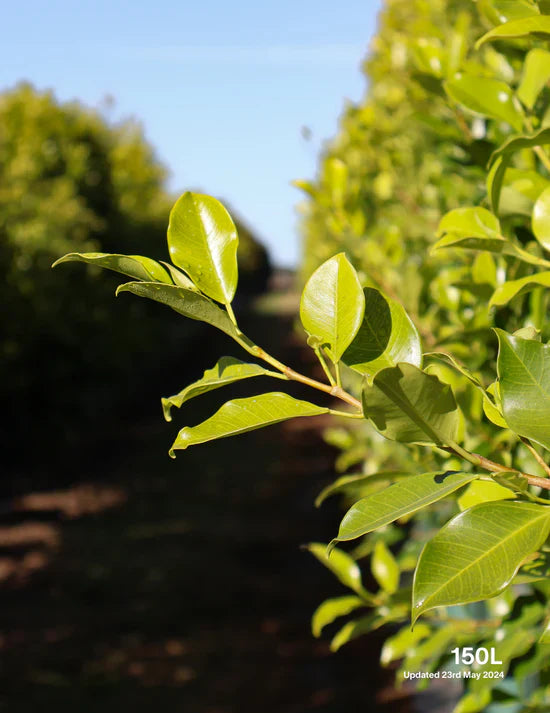When selecting trees for your high-end garden, the key to long-term beauty and success lies beneath the surface. Healthy roots are the foundation of a thriving tree, and knowing how to assess root health is essential for making informed choices. In this guide, we’ll explore what to look for when buying trees, focusing on the vital aspect of root health, and highlight three exceptional species: Acer Rubrum, Liquidambar Styraciflua, and Ficus Flash.
The Importance of Root Health in Tree Selection
Root health is often overlooked but plays a critical role in a tree's overall vitality. Strong, well-developed roots ensure the tree can anchor itself securely in the soil, absorb necessary nutrients, and withstand environmental stressors. When selecting a tree, especially for a luxurious garden, understanding and inspecting the root system can save you from future issues and help your trees flourish.
Signs of Healthy Roots:
- Color: Healthy roots are typically white or light tan. Avoid trees with roots that appear dark, slimy, or rotten.
- Structure: Look for a dense, fibrous root system with many fine roots. These finer roots are essential for nutrient uptake.
- Container Growth: If the tree is container-grown, ensure the roots aren't circling the pot excessively, which can lead to girdling and poor growth.
Now, let's delve into three tree species that offer visual appeal and have robust root systems that support their growth and longevity.
Acer Rubrum (Red Maple)
The Acer Rubrum, commonly known as the Autumn Red, is a deciduous tree renowned for its stunning red foliage in the autumn. Its adaptability to various soil types makes it a versatile choice for high-end gardens, particularly those looking to add a splash of seasonal color.
Key Facts:
- Mature Height: 12-18 meters
- Mature Width: 10-15 meters
- Best Uses: Feature tree, shade tree, and seasonal color
- Leaf Appearance: Medium to dark green leaves in summer, turning vibrant red in autumn
- Rate of Growth: Moderate to fast
- Tolerates: Wet soils, drought, and varying pH levels

Why It’s Perfect to Add to Your Garden
The Acer Rubrum 'Autumn Red' is an excellent choice for gardens that prioritize aesthetic appeal and adaptability. Its robust root system ensures stability and nutrient absorption, making it resilient against environmental challenges. As a feature tree, it provides a striking focal point, especially in autumn when its leaves turn a brilliant red. Additionally, its fast growth rate allows it to establish itself quickly in the landscape, offering shade and beauty relatively quickly.
Liquidambar Styraciflua (American Sweetgum)
The Liquidambar Styraciflua, or American Sweetgum, is a deciduous tree known for its star-shaped leaves and striking autumn colors that range from yellow to deep burgundy. Its unique bark and symmetrical shape add elegance to any garden setting.
Key Facts:
- Mature Height: 20-25 meters
- Mature Width: 12-15 meters
- Best Uses: Feature tree, shade tree, and seasonal color
- Leaf Appearance: Glossy, star-shaped leaves that transition to a vibrant mix of colors in autumn
- Rate of Growth: Moderate
- Tolerates: Wet soils, compacted soils, and urban pollution

Why It’s Perfect to Add to Your Garden
The Liquidambar Styraciflua is a tree that offers both visual interest and durability. Its extensive root system supports its towering height, making it a stable and long-lasting addition to any garden. The tree's star-shaped leaves provide a unique texture, while its autumn display of colors creates a dynamic and ever-changing landscape. It's particularly suited for large gardens where it can be used as a majestic centerpiece or to provide shade and seasonal interest.
Ficus Flash (Ficus Hillii 'Flash')
The Ficus Flash, also known as Ficus Hillii 'Flash', is an evergreen tree highly valued for its lush foliage and rapid growth. It's ideal for creating privacy screens or hedges in upscale gardens.
Key Facts:
- Mature Height: 6-8 meters
- Mature Width: 3-4 meters
- Best Uses: Screening tree, hedge, and feature tree
- Leaf Appearance: Glossy, dark green leaves that maintain their color year-round
- Rate of Growth: Fast
- Tolerates: Pruning, drought, and urban conditions
Why It’s Perfect to Add to Your Garden
The Ficus Hillii 'Flash' is the epitome of elegance and functionality. Its fast growth rate and dense foliage make it perfect for creating lush, green screens that provide privacy and a sense of seclusion in your garden. The tree's root system is strong and adaptable, capable of thriving in various soil conditions, ensuring its longevity and robustness in the landscape. Whether used as a standalone feature or as part of a hedge, the Ficus Flash brings a touch of luxury to any garden setting.
FAQs
What should I look for when inspecting a tree's roots before purchase?
Look for healthy roots that are white or light tan in color and have a dense network of fine roots. Avoid trees with roots that circle the pot excessively or appear dark and slimy.
Why is root health so important when choosing a tree?
Root health is crucial because it affects the tree's ability to absorb nutrients, anchor itself in the soil, and withstand environmental stressors. A tree with a healthy root system is likelier to thrive and grow strong.
How do I know if a tree is suitable for my garden?
Consider the tree’s mature size, growth rate, and tolerance to your garden's conditions (soil type, sunlight, etc.). Ensure the tree’s root system is healthy, as this will support its long-term growth and vitality.
Conclusion
Choosing quality trees for your garden is an investment in your landscape's future beauty and sustainability. By focusing on root health, you can ensure that the trees you select will thrive, providing lasting value and enhancing the elegance of your garden. Whether you opt for the vibrant Acer Rubrum, the stately Liquidambar Styraciflua, or the versatile Ficus Flash, each tree offers unique qualities that make it a worthy addition to any high-end garden. Remember, the key to a flourishing garden lies in the roots—choose wisely, and your trees will reward you for years.








